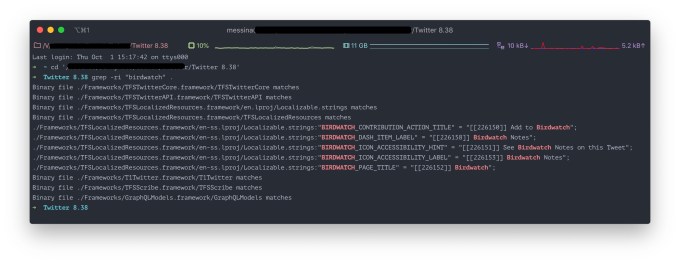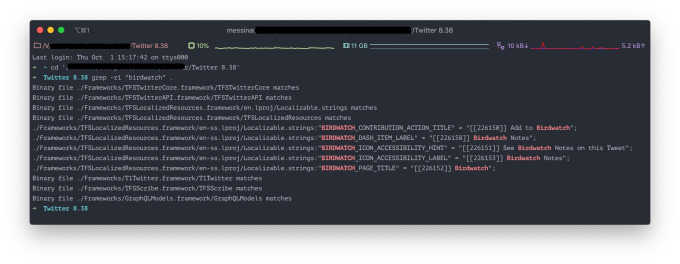Twitter is developing a new product called “Birdwatch,” which the company confirms is an attempt at addressing misinformation across its platform by providing more context for tweets, in the form of notes. Tweets can be added to “Birdwatch” — meaning flagged for moderation — from the tweet’s drop-down menu, where other blocking and reporting tools are found today. A small binoculars icon will also appear on tweets published to the Twitter Timeline. When the button is clicked, users are directed to a screen where they can view the tweet’s history of notes.
Based on screenshots of Birdwatch unearthed through reverse engineering techniques, a new tab called “Birdwatch Notes” will be added to Twitter’s sidebar navigation, alongside other existing features like Lists, Topics, Bookmarks and Moments.
This section will allow you to keep track of your own contributions, aka your “Birdwatch Notes.”
The feature was first uncovered this summer in early stages of development by reverse engineer Jane Manchun Wong, who found the system through Twitter’s website. At the time, Birdwatch didn’t have a name, but it clearly showed an interface for flagging tweets, voting on whether or not the tweet was misleading, and adding a note with further explanations.
Twitter is working on a moderation tool to monitor misinformations on Twitter
Moderators can flag tweets, vote on whether it is misleading, and add a note about it
(I made up my own note to show what it currently looks like) pic.twitter.com/YIa6zt58Fj
— Jane Manchun Wong (@wongmjane) August 5, 2020
Twitter updated its web app a few days after her discovery, limiting further investigation.
This week, however, a very similar interface was again discovered in Twitter’s code, this time on iOS.
According to social media consultant Matt Navarra, who tweeted several more screenshots of the feature on mobile, Birdwatch allows users to attach notes to a tweet. These notes can be viewed when clicking on the binoculars button on the tweet itself.
In other words, additional context about the statements made in the tweet would be open to the public.
New Twitter feature?
‘Birdwatch’?! 🐦
Any guesses what it does? pic.twitter.com/1vmpZdTKLi
— Matt Navarra (@MattNavarra) September 30, 2020
What’s less clear is whether everyone on Twitter will be given access to annotate tweets with additional context, or whether this permission will require approval, or only be open to select users or fact checkers.
Twitter early adopter and hashtag inventor Chris Messina openly wondered if Birdwatch could be some sort of “citizen’s watch” system for policing disinformation on Twitter. It turns out, he was right.
Wondering out loud if Twitter’s #Birdwatch feature might turn into a kind of “citizen’s watch” for disinformation on Twitter… 👀 https://t.co/N1YlVkbu8m
— Chris Messina (@chrismessina) October 1, 2020
According to line items he found within Twitter’s code, these annotations — the “Birdwatch Notes” — are referred to as “contributions,” which does seem to imply a crowdsourced system. (After all, a user would contribute to a shared system, not to a note they were writing for only themselves to see.)

Image Credits: Chris Messina
Crowdsourcing moderation wouldn’t be new to Twitter. For several years, Twitter’s live-streaming app Periscope has relied on crowdsourcing techniques to moderate comments on its real-time streams in order to clamp down on abuse.
There is still much we don’t know about how Birdwatch will work from a non-technical perspective, however. We don’t know if everyone will have the same abilities to annotate tweets, how attempts to troll this system will be handled, or what would happen to a tweet if it got too many negative dings, for example.
In more recent months, Twitter has tried to take a harder stance on tweets that contain misleading, false or incendiary statements. It has even gone so far as to apply fact-check labels to some of Trump’s tweets and has hidden others behind a notice warning users that the tweet has violated Twitter’s rules. But scaling moderation across all of Twitter is a task the company has not been well-prepared for, as it built for scale first, then tried to figure out policies and procedures around harmful content after the fact.
Reached for comment, Twitter declined to offer details regarding its plans for Birdwatch, but did confirm the feature was designed to combat the spread of misinformation.
“We’re exploring a number of ways to address misinformation and provide more context for tweets on Twitter,” a Twitter spokesperson told TechCrunch. “Misinformation is a critical issue and we will be testing many different ways to address it,” they added.













